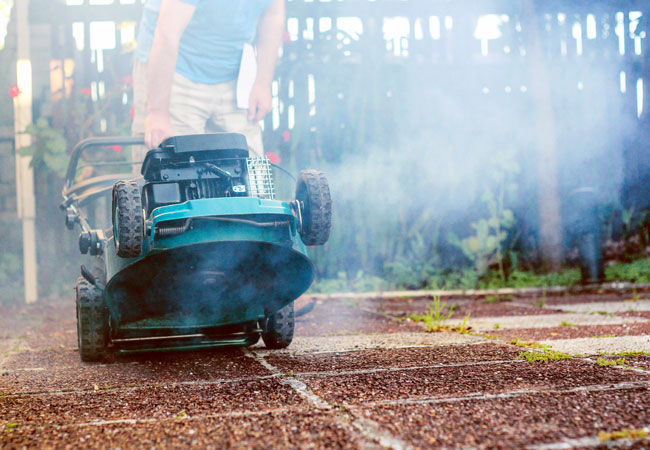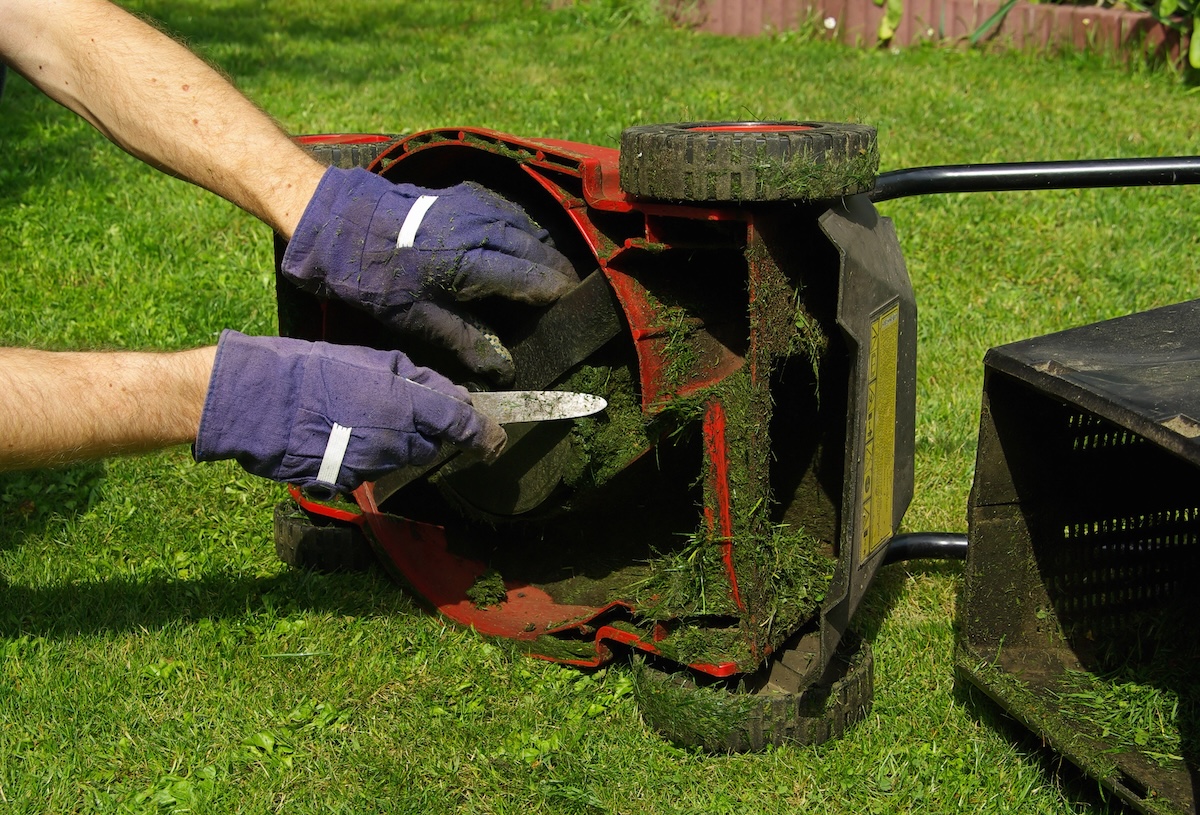

We may earn revenue from the products available on this page and participate in affiliate programs. Learn More ›
Noticing smoke from a lawn mower or a strange cloud puffing from the engine can be quite alarming, but it doesn’t always mean disaster. A lawn mower smoking, whether it’s blue, white, or black, is usually a sign that something’s off, but many of the most common causes are easy to spot (and even easier to fix). The trick is identifying what color smoke you’re seeing and know what that means.
This guide will walk you through the potential reasons for a smoking mower, what each smoke color can indicate, and how to tell when it’s a simple fix you can do yourself—or time to call in a pro.
Reasons Your Lawn Mower is Smoking
Leaking Oil
If you’ve recently changed the oil in your mower and the lawn mower is smoking white or blue, there’s a good chance that some of the oil spilled onto the engine. Oil can leak or spill if you’ve been mowing on a slope greater than 15 degrees or if the mower was tipped on its side during cleaning or maintenance. While the cloud of smoke may look dramatic, it’s usually harmless.
How to fix it:
- Restart the mower and let the excess oil burn off.
- Avoid tipping the mower unless necessary; consult your manual for safe positioning.
- Use the correct oil for your machine to minimize leaks.
You Overfilled the Oil Reservoir
Too much oil in the reservoir can cause blue smoke from the lawn mower or a thick white cloud. When the engine is overfilled, excess oil can leak into the combustion chamber or onto other hot parts of the mower, causing it to smoke. Overfilling can also lead to poor engine performance over time.
How to fix it:
- Check the oil level using the dipstick: remove it, wipe it clean, reinsert it, then pull it out again to compare with the “fill” line.
- If the level is too high, carefully drain some oil (your owner’s manual will explain how).
- Refill gradually. Start with about ¾ of the recommended amount, then top off slowly until you reach the correct level.
- Double-check you’re using the correct oil grade; the wrong lawn mower oil type can also cause white smoke from the machine.
Your Air Filter is Clogged
If you see black smoke from a lawn mower, it may be because the engine is “running rich,” meaning it’s burning too much gasoline. This typically happens when the carburetor isn’t getting enough air to balance the fuel mixture, often due to a dirty or clogged air filter that’s restricting airflow.
How to fix it:
- Check and replace the air filter if it looks dirty or clogged (filters vary by model, so check your manual or look for a compatible option online).
- After replacing the filter, run the mower for a few minutes to see if the smoke clears up.
- If you still have a smoking mower, the carburetor may need adjusting. Follow your owner’s manual to do it yourself, or take the mower to a pro.
Something is Caught in the Blades of Your Electric Mower
If your electric mower starts smoking and the blades won’t turn, it’s possible that debris, like tall grass, twigs, or other obstructions, has become lodged in the blades. This blockage can strain the motor, causing it to overheat and emit smoke.
How to fit it:
- Turn off and unplug the mower to ensure safety.
- Take a look at the blade area for any debris or obstructions.
- Carefully remove any blockages using appropriate tools.
- Let the mower cool down before starting it up again.
Mechanical or Electrical Issues
Persistent smoking may indicate more serious mechanical or electrical problems, such as a seized engine, worn-out bearings, or electrical shorts. For electric mowers, issues like a shorted motor winding or damaged wiring can cause smoke and are often signs of significant internal damage.
How to fix it:
- Stop use immediately to prevent further damage.
- Talk to a professional technician to diagnose and repair the issue.
- Evaluate the cost of repairs versus replacement. If the mower is older or repairs are extensive, replacing the mower might be more cost-effective.
Lawn Mower Smoke Color Meanings
The color of the smoke can give you a solid clue about what’s going wrong. Here’s what different colors typically mean:
White Smoke
White smoke from a lawn mower or a bluish haze usually means that oil is burning where it shouldn’t be. This can happen if oil has spilled onto the engine, the oil reservoir is overfilled, or oil has leaked into the combustion chamber, especially after the mower was tipped or used on a steep slope. It’s one of the more common issues and often not a major cause for concern.
Black Smoke
Thick, dark smoke coming from a mower usually means that the engine is burning too much fuel. This is called “running rich,” and it’s often caused by a clogged air filter or a carburetor issue that’s messing with the air-to-fuel ratio. Black smoke may also be accompanied by a drop in performance or a rough-sounding engine.
Blue Smoke
Though it can be tricky to distinguish from white, blue smoke from a lawn mower tends to indicate that oil is actively being burned inside the engine. This can be due to worn piston rings, valve seals, or internal engine damage. If the smoke doesn’t clear up quickly, this may require a more advanced fix (or a visit to a repair shop).
How to Prevent a Smoking Lawn Mower

Routine lawn mower maintenance goes a long way in keeping your mower running clean and smooth. Here are some simple steps that can help:
- Clean or replace the air filter regularly to ensure proper airflow to the engine.
- Change the oil as recommended in your mower’s manual to avoid buildup or burning.
- Check the oil level before each mow to avoid overfilling or running dry.
- Use the correct grade of engine oil for your specific mower model.
- Keep the mower deck and blades clear of debris that can strain the engine or motor.
- Avoid mowing on steep slopes to prevent oil from spilling into the engine.
- Inspect the spark plug and fuel lines periodically to catch early signs of wear or clogging.
- Store your mower properly—in a dry, sheltered area—to prevent corrosion or leaks.
A few minutes of regular upkeep can save you from dealing with a smoking push mower when you least expect it.
FAQs
If your lawn mower is dying after basic troubleshooting, or if you think there might be engine damage, electrical issues, or carburetor problems, it’s best to contact a professional.
With proper maintenance, most gas-powered lawn mowers last 8 to 10 years. Electric mowers can last 5 to 7 years, depending on use and battery life.
A small amount of white or blue smoke from a lawn mower can be normal right after startup—especially if oil has spilled—but ongoing smoke signals a problem that needs attention.
Signs include white smoke from the lawn mower, oil leaks, or a sputtering engine. You can confirm by checking the dipstick and comparing it to the fill line.
Check the air filter every 25 hours of use. Clean it if it’s dirty, and replace it at least once per mowing season (or more often in dusty conditions).
